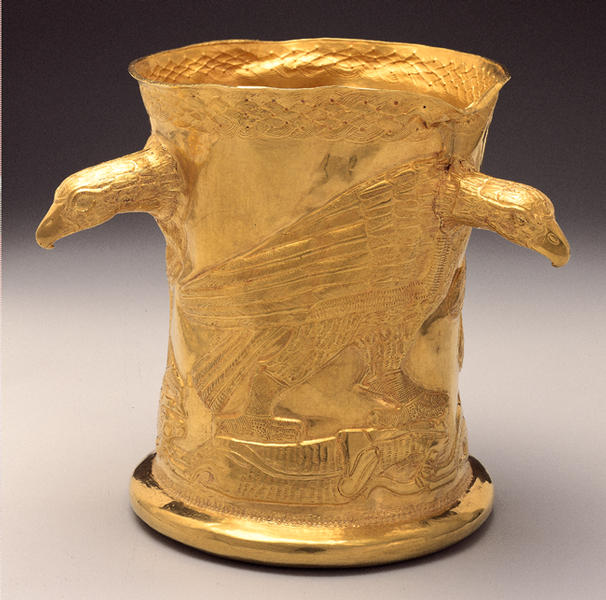猛禽装飾杯
- イラン北西部
- 紀元前12-紀元前11世紀
- 金
- H-13.7 D-12
この印象的な鳥頭部は容器胴部とは別に作られており、それぞれが、1個は首の真上に、もう1個は首の真下に付けられた2個の小さな金製リベットで器壁に固定されている。表面に羽毛が描かれたのは頭が取り付けられた後であり、それによって鳥頭部と容器胴部との接合部がほぼ完全に見えなくなっている。引き締まった形とうろこのような滑らかな羽毛によって、この鳥の頭部は爬虫類のように見える。現在は失われてしまったがかつて目に施されていた象嵌によって、そのような印象はもっと強調されていただろう。平らな底部には大きな円が線刻されており、その内部には重なり合う小さな6弁の円花文がある。打刻された小さな円が、これらの円花の花弁、そして円花と円形の輪郭刻線の間の空間を埋めている。それぞれの円花には中心を示すために球形のパンチであけられた小さな穴があり、長い花弁の間にはさらに小さな花弁が蕾を出している。
ライベイション
メソポタミアには潅奠(ライベイション)という液体を注ぐ宗教的儀礼が古くからありますが、井戸の冷水、聖水が神々に捧げられました。
南メソポタミアのバビロニアでは、死者に対する潅奠は水のみが使われたようです。更に、メソポタミアの神話には「生命の水」を捧げる話が見られます。
また神々には酒が捧げられる事も多く、ミルク、蜂蜜、油あるいはクリームが伴う事もありました。
灌奠にあたって、液体は祭主のまわりの地面に杯、椀、瓶などから注がれましたが、その器はしばしば金銀など高価な材質でつくられました。
あるいは犠牲の羊の頭、川、泉、または第二の器や門戸などにも注がれました。
嘴形注口容器
人物文様杯
猛禽文様杯
牡牛装飾脚杯
形式について
この金杯は器の下部が丸く帯状に突出した、いわゆるマルリク型の形態をあらわし、器底にもマルリク型容器の特徴である幾何学的な花文様が描かれています。
猛禽類が山羊を捉えている装飾意匠で、立体的に現された猛禽類の頭部が、器上の毛彫りで現された胴体につながっているように外からかぶせられ、その接合部はリベットで留め、外部のリベットの頭は接合部と同様に猛禽の羽毛が毛彫りされ目立たくなっています。
これと大変類似したものにマルリクの東、テヘランの北にあたるカラール・ダシュト出土の金杯がありますが、立体的に表現されたライオンの頭部が器から突出している意匠で、接合部はやはりリベット留めされています。
このような立体的な獣の頭部を持った金属器は南イランのエラム王国由来のものがよく知られています。おそらくこのエラムの影響がこの器にもあらわれているものと思われます。
・H.Samadi/Les Decouvertes Fortuites/ Arts Asiatiques VI 1959-3
・P.Amiet / Elam, Auvers-sur-Oise, 1966
Catalogue Entry
This large, flat-bottomed cup has a narrow ridge around the base and slightly concave sides that are dramatically interrupted by the heads of three large raptors, or birds of prey. Each bird, moving to the viewer's right, treads on the supine body of a dorcas gazelle. The birds' small heads, with hooded eyes, and their long, slender necks, protrude abruptly at right angles, suggesting vultures rather than eagles. The three-dimensional extension of the heads and necks, combined with the sharp lines of the wings, tails, and legs, creates the illusion of movement-an almost hostile turning toward the spectator. These striking heads were made separately from the body of the vessel to which each was fastened with two small gold rivets, one at the top of the neck and the other at the bottom. Only after the heads were attached were the feathers worked on the surface, virtually obliterating the join between the two pieces. Their compact forms and smooth, scale-like feathers give a reptilian appearance to the birds' heads that would have been enhanced by the inlays in the eyes, which now are missing. The flat bottom bears a pattern of small interlocking six-petaled rosettes within a large, inscribed circle. Small punched circlets fill the petals of the rosettes and the spaces between the rosettes and the inscribed circular border. Each rosette has a small dot made with a ball punch marking its center as well as additional tiny petals budding between the longer ones.
The closest parallel to this cup in material, proportions, and method of attaching the heads is a gold cup with striding lions,1 excavated at Kalar Dasht north of Tehran, near the Caspian Sea, although the Kalar Dasht, cup is far cruder in the manner in which the lions' heads are joined to the vessel. Images of vultures and their prey appear on a tall gold cup from Marlik on which, among other images, three pairs of vultures tear at dead gazelles.2 The Marlik raptors, however, are arranged symmetrically, are worked in low relief, and focus only on the gazelles, with none of the outward motion of the Shumei birds. A small silver fragment, of uncertain provenance, bears an abbreviated version of the same scene.3 Nevertheless the sculptural effect of the cup with vultures, as well as details of style, composition, and execution, set it apart from these less dynamic versions. Rather than being a subsidiary motif, the vulture is the main subject-an image of power and dominance, whose broader cultural significance still eludes us.
TSK
1. See Metropolitan Museum 1996, p. 32, fig. 1.
2. See ibid., p. 33, fig. 2.
3. See Porada 1972, pp. 164-65, 173-75.
